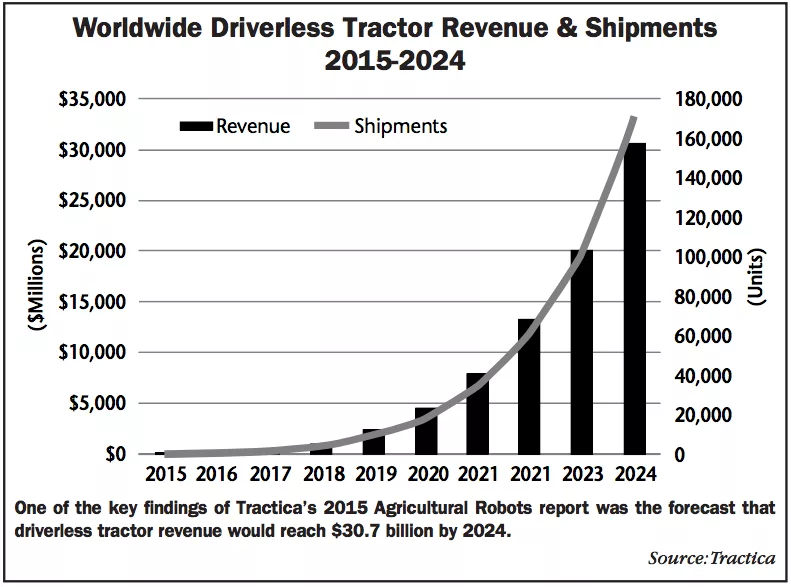“The impact of driverless tractors on farm operations will be dramatic, and the vehicles hold the potential to provide a huge boost to productivity,” says Manoj Sahi of Tractica. In a report issued on Sept. 4, following the introduction of Case IH and New Holland’s concept autonomous tractors at the Farm Progress Show on Aug. 30, Tractica said it expects rapid growth of driverless farm vehicles starting about 2020.
Based in Boulder, Colo., Tractica is a market intelligence firm that focuses on human interaction with technology. In 2015, the company conducted an extensive study of the agricultural robot market opportunity, the findings of which were published in a report entitled “Agricultural Robots.”
Sahi said, “The research was focused on the applications, market drivers and key challenges that could impact the growth of agricultural robots. One of the key findings of our report was the forecast that driverless tractor revenue would reach $30.7 billion by 2024.
“Like any other autonomous or semi-autonomous (supervised) unmanned ground vehicles (UGVs), driverless tractors are programmed to navigate, understand their position, determine speed and avoid obstacles, such as people, animals or objects in the field, while performing their tasks.”
According to Case IH Brand President Andreas Klauser, the concept was created to validate the technology and to collect customer feedback regarding their interest and need for future autonomous products for their operations. “In many parts of the world, finding skilled labor during peak-use seasons is a constant challenge for our customers,” Klauser said.
Autonomous Solutions Inc. (ASI) is CNH Industrial’s technology provider responsible for developing and refining autonomous vehicle technology for concept autonomous tractors, including the Case IH Magnum and New Holland T8 NHDrive.
According to Tractica, ASI, which is based in Utah, is the industry leader in off-road autonomous solutions with nearly 2 decades of experience in the domain. Sahi said, “As a smaller and more agile technology developer, ASI is able to partner with large global companies such as CNH Industrial to help them go to market with multi-vehicle autonomy faster and more economically than they could in any other way.
“These tractors will have the ability for autonomous seeding, planting and tillage for broadacre and row-crop farming. ASI believes that its advanced path planning technology, along with obstacle detection, would enable farmers to manage their fields more efficiently and safely,” said Sahi. “Through the use of radar, lidar and onboard video cameras, the vehicle could sense stationary or moving obstacles in its path and would stop on its own until the operator, notified by audio and visual alerts, assigns a new path.”
According to Tractica, at present, apart from CNH Industrial and ASI, there are other companies including a few startups that have been actively working to produce marketable driverless tractors and have made strides toward substantial prototypes and testing. The prominent ones among these are John Deere, AGCO and Autonomous Tractor Corp. Sahi went on to say, “In Tractica’s analysis, driverless tractors are certainly on the right track and the future looks promising.
“Tractica believes the driverless tractor market will continue to evolve relatively quickly and by 2020, the market opportunities should be attractive enough to pull in many of the non-agricultural companies that are currently involved with driverless technology,” he said.
— Ag Equipment Intelligence, September 2016







